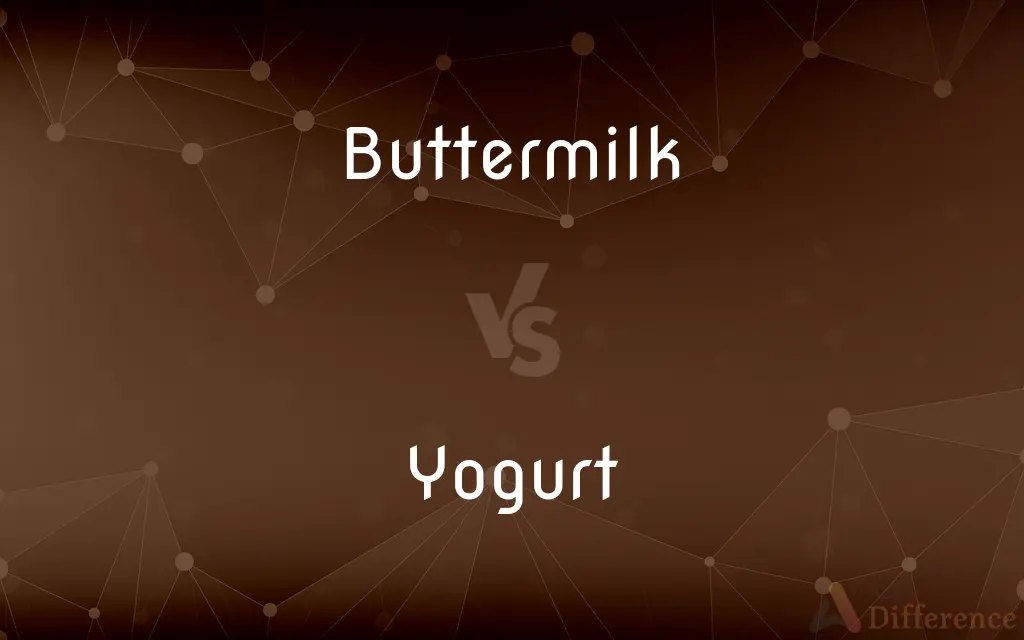Buttermilk vs. Yogurt — What's the Difference?
By Tayyaba Rehman — Updated on October 12, 2023
Buttermilk is the liquid left after churning butter, while yogurt is fermented milk using specific bacteria. Both are tangy but differ in consistency, taste, and production processes.

Difference Between Buttermilk and Yogurt
Table of Contents
ADVERTISEMENT
Key Differences
Buttermilk and Yogurt are both dairy products, but they originate from different production methods. While they share a tangy flavor, they have distinct textures and uses in culinary practices.
Buttermilk traditionally refers to the liquid left after churning butter from cream. Today, the commercial buttermilk is often cultured, meaning it's made by adding lactic acid bacteria to milk. Yogurt, on the other hand, is created by fermenting milk using specific bacterial cultures, leading to its characteristic consistency and tang.
In terms of consistency, Buttermilk tends to be thinner, closer to milk, but with a tangy flavor. Yogurt is thicker due to the fermentation process and can range from a runny to a near-solid consistency, depending on the type and production method.
Culinary uses for Buttermilk and Yogurt differ. Buttermilk is often used in baking, as its acidity can react with baking soda to produce carbon dioxide, aiding in leavening. Yogurt is versatile, consumed on its own, in smoothies, or as a base for various dishes and sauces.
Nutritionally, both Buttermilk and Yogurt offer probiotics and can be beneficial for gut health. However, Yogurt typically has a higher protein content, while Buttermilk might have a slightly reduced fat content, especially if derived from low-fat milk.
ADVERTISEMENT
Comparison Chart
Origin
Liquid after churning butter
Fermented milk using bacteria
Consistency
Generally thinner
Thicker, can vary based on type
Production
Traditionally from butter; now often cultured
Fermented with specific bacterial cultures
Culinary Uses
Baking, pancakes
Consumed directly, in dishes, sauces, or smoothies
Nutritional Content
Probiotics, might have reduced fat
Probiotics, typically higher protein content
Compare with Definitions
Buttermilk
The liquid residue left after churning butter.
The pancakes made with Buttermilk were especially fluffy.
Yogurt
A thick, fermented milk product.
He topped his Yogurt with fresh berries for breakfast.
Buttermilk
A tangy milk beverage, often cultured in modern production.
She drank a glass of Buttermilk for its probiotic benefits.
Yogurt
A versatile base for desserts, sauces, and marinades.
She used Yogurt to make a creamy cucumber sauce.
Buttermilk
A dairy product used to add acidity in baking.
Buttermilk reacted with the baking soda to rise the dough.
Yogurt
Comes in various forms, including Greek, regular, and flavored.
He preferred Greek Yogurt due to its thicker texture.
Buttermilk
A thinner alternative to yogurt or sour cream in recipes.
She used Buttermilk in her dressing for a lighter consistency.
Yogurt
Dairy produced by bacterial fermentation of milk.
The bacteria in Yogurt can be beneficial for gut health.
Buttermilk
Often used in marinades to tenderize meat.
The chicken was soaked in Buttermilk before frying.
Yogurt
A popular source of probiotics and protein.
Consuming Yogurt regularly can aid in digestion.
Buttermilk
Buttermilk is a fermented dairy drink. Traditionally, it was the liquid left behind after churning butter out of cultured cream; however, as most modern butter is made not with cultured cream, but with sweet cream, most modern buttermilk is cultured.
Yogurt
Yogurt (UK: ; US: , from Turkish: yoğurt) also spelled yoghurt, yogourt or yoghourt, is a food produced by bacterial fermentation of milk. The bacteria used to make yogurt are known as yogurt cultures.
Buttermilk
The liquid, usually either naturally soured or cultured with acid-producing bacteria, that remains after the butterfat has been removed from cream by churning.
Yogurt
A semi-solid sourish food prepared from milk fermented by added bacteria, often sweetened and flavoured
Low-fat yogurt
Frozen yogurts
Buttermilk
A sour milk made by culturing usually skim milk with acid-producing bacteria.
Yogurt
A custardlike food with a tart flavor, prepared from milk curdled by bacteria, especially Lactobacillus bulgaricus and Streptococcus thermophilus, and often sweetened or flavored.
Buttermilk
The liquid left over after producing butter from full cream milk by the churning process, also called traditional buttermilk.
Yogurt
A milk-based product stiffened by a bacterium-aided curdling process, and sometimes mixed with fruit or other flavoring.
Buttermilk
Cultured buttermilk, a fermented dairy product produced from cow's milk, with a characteristically sour taste.
Yogurt
Any similar product based on other substances (e.g. soy yogurt).
Buttermilk
The milk that remains after the butter is separated from the cream.
Yogurt
A custard-like food made from curdled milk
Buttermilk
Residue from making butter from sour raw milk; or pasteurized milk curdled by adding a culture
Common Curiosities
Is Buttermilk thicker than regular milk?
Generally, Buttermilk is slightly thicker than regular milk but thinner than Yogurt.
Can Yogurt be used as a substitute for Buttermilk in recipes?
Yes, Yogurt can replace Buttermilk in recipes, but adjustments might be needed for consistency.
Does Buttermilk have probiotics like Yogurt?
Yes, both Buttermilk and Yogurt can contain probiotics beneficial for gut health.
How is Yogurt made?
Yogurt is made by fermenting milk using specific bacterial cultures.
Which is tangier, Buttermilk or Yogurt?
Both have a tangy taste, but this can vary by brand and fermentation time; Buttermilk is typically tangier.
What is Buttermilk?
Buttermilk is the liquid left after churning butter, though commercially it's often cultured milk.
Can I use Buttermilk in smoothies?
Absolutely, Buttermilk can add a tangy flavor to smoothies, just as Yogurt does.
What gives Buttermilk its tangy flavor?
The tang in Buttermilk comes from the acids produced during fermentation or the butter churning process.
Can I make Buttermilk at home?
Yes, by adding lemon juice or vinegar to milk, you can create a Buttermilk substitute.
Is Yogurt suitable for lactose-intolerant individuals?
Some people find fermented dairy like Yogurt easier to digest, but it's individual-specific.
Is Greek Yogurt thicker than regular Yogurt?
Yes, Greek Yogurt is strained and has a thicker consistency than regular Yogurt.
How is Yogurt different from kefir?
While both are fermented, Yogurt uses specific bacteria, whereas kefir uses both bacteria and yeast.
Does freezing Yogurt kill its probiotics?
Freezing Yogurt may reduce its probiotic count but won't eliminate them entirely.
Why is Buttermilk used in baking?
Buttermilk's acidity can react with leavening agents, aiding in rising.
Share Your Discovery

Previous Comparison
Mainframe vs. Server
Next Comparison
Salmon vs. GoldfishAuthor Spotlight
Written by
Tayyaba RehmanTayyaba Rehman is a distinguished writer, currently serving as a primary contributor to askdifference.com. As a researcher in semantics and etymology, Tayyaba's passion for the complexity of languages and their distinctions has found a perfect home on the platform. Tayyaba delves into the intricacies of language, distinguishing between commonly confused words and phrases, thereby providing clarity for readers worldwide.














































